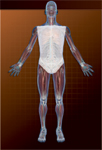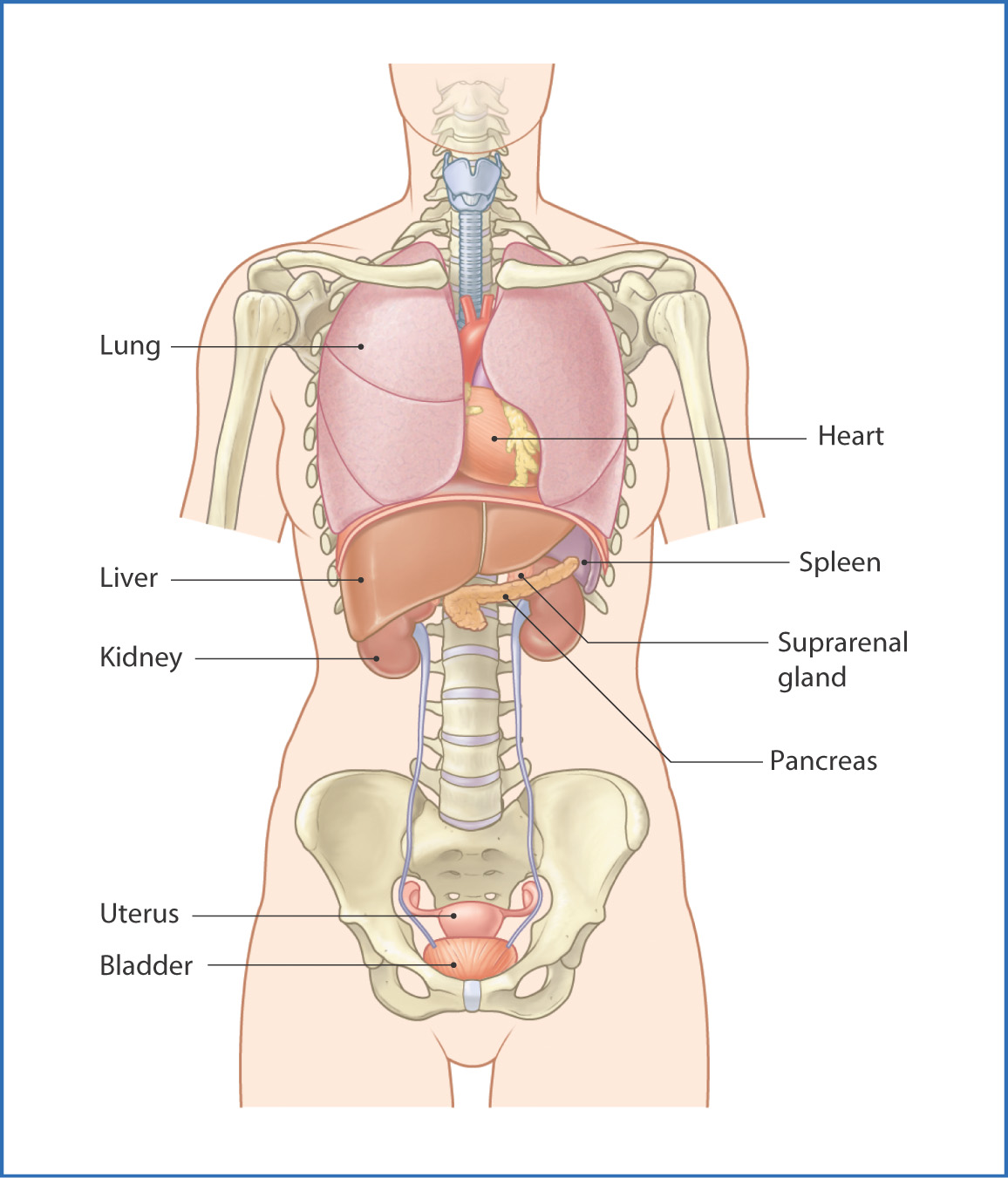
25
Introduction to the Trunk
The thorax, abdomen, and pelvis—together with the back—are collectively referred to as the “trunk.” These areas are described here together because of their close interrelationships.
The thorax is the part of the trunk above the diaphragm. It contains and protects the principal organs of respiration (lungs) and circulation (heart) and part of the gastrointestinal tract (esophagus) (Fig. 25.1).

FIGURE 25.1 Organs in the upper part of the trunk.
The thorax communicates with the neck at the superior thoracic aperture (thoracic inlet) and is enclosed by the diaphragm at the inferior thoracic aperture (thoracic outlet). Its walls are composed of
- the 12 thoracic vertebrae posteriorly
- the sternum anteriorly
- the 12 pairs of ribs and their costal cartilages laterally
- the sternum anteriorly
The superior thoracic aperture is kidney shaped, slopes downward and forward, and is bounded posteriorly by vertebra TI, anteriorly by the superior border of the manubrium of the sternum, and laterally by rib I and its costal cartilage. It is a passageway for the trachea and esophagus and the large vessels and nerves of the head, neck, and upper limbs. The cervical pleura (external lining of the lung) and apex of each lung are at its lateral margins.
Inferiorly, the inferior thoracic aperture is bounded anteriorly by the costal cartilages of ribs VII to X, laterally by ribs XI and XII, and posteriorly by vertebra TXII.
The abdomen lies between the thorax and pelvis. The abdominal cavity is separated from the thoracic cavity by the diaphragm and from the pelvis by an imaginary line at the pelvic inlet. The abdominal cavity is, in a broad sense, continuous with the pelvic cavity. The abdominal and pelvic organs encroach on and share parts of their respective cavities.
The abdominal cavity contains most of the gastrointestinal organs (stomach, intestines, liver, pancreas, and part of the colon), part of the urinary system (kidneys and ureters), the spleen, and the suprarenal glands. It is lined with a serous membrane—the peritoneum.
For descriptive and diagnostic purposes, the anterior abdominal wall is divided into a grid-like pattern with nine regions (Fig. 25.2). The umbilical region containing the umbilicus is at the center. Superior to the umbilical region is the epigastric region, and inferior to it is the pubic region. Laterally, from superior to inferior, are the left and right hypochondria, the flanks, and the groin. The anterior abdominal wall is often described as four quadrants, again centered around the umbilicus (left and right upper quadrants and left and right lower quadrants).

FIGURE 25.2 Nine regions of the abdomen.
The abdominal wall is supported posteriorly by the five lumbar vertebrae, the crura of the diaphragm, the psoas major and minor muscles, and the quadratus lumborum muscle.
The pelvis is the part of the trunk below and behind the abdomen. It contains the lower part of the gastrointestinal tract, the urinary bladder, the inferior parts of the ureters, and portions of the male and female reproductive organs.
The skeletal framework for the pelvis is a ring of bone formed by the sacrum, ilium, and pubis. This bony girdle transmits the weight of the trunk to the lower limbs through the hip joint.
The back is the posterior part of the trunk and includes the posterior skin and muscles, the vertebral column, the spinal cord, and neurovascular structures.
Bones
The bony vertebral column extends from the base of the skull to the coccyx. It protects the spinal cord and supports the weight of the trunk, transferring it to the pelvis and lower limbs. Because most of the weight of the trunk is anterior to the vertebral column, the column is supported by layers of muscles that act as levers and strong extensors and rotators to maintain stability and enable movement. There are 33 vertebrae—7 cervical, 12 thoracic, 5 lumbar, 5 sacral, and 4 coccygeal. The sacrum and coccyx are formed from fused sacral and coccygeal vertebrae, respectively.
Muscles
The muscles of the trunk are at the periphery of the chest, abdomen, pelvis, and back and are subdivided into chest wall, back, and abdominal muscles and muscular support for the pelvis. These muscles
Stay updated, free articles. Join our Telegram channel

Full access? Get Clinical Tree


